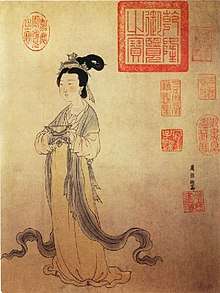Du Qiuniang
| Du Qiuniang | |||||||||
 Portrait of Du by Yuan dynasty painter Zhou Lang, ca. 1300 | |||||||||
| Traditional Chinese | 杜秋娘 | ||||||||
|---|---|---|---|---|---|---|---|---|---|
| Simplified Chinese | 杜秋娘 | ||||||||
| Literal meaning | Autumn Maid Du | ||||||||
| |||||||||
Du Qiuniang or Lady Du Qiu (?–825?) was a Tang dynasty Chinese poet. She is the only female poet to be included in the famous anthology Three Hundred Tang Poems.
Life
Born in Jinling (modern Nanjing), she became a concubine of the military governor Li Qi at fifteen. After Li was executed for rebelling against Emperor Xianzong, Du served in the emperor's palace.
Golden Dress Song
Her only surviving poem is the Golden Dress Song (simplified Chinese: 金缕衣; traditional Chinese: 金縷衣; pinyin: Jīnlǚyī), said to have been addressed to Li (translation by Victor Mair):
I urge you, milord, not to cherish your robe of golden thread,
Rather, milord, I urge you to cherish the time of your youth;
When the flower is open and pluckable, you simply must pluck it,
Don't wait till there are no flowers, vainly to break branches.
The "robe of golden thread" is a synecdoche for Li Qi's official career.[1][2]
The Golden Dress Song, counseling the listener to enjoy the fleeting pleasures of youth, has been compared to Robert Herrick's To the Virgins, to Make Much of Time.[3]
Legacy
When she was living, poor and old, in her hometown, the poet Du Mu visited her and wrote a poem about the experience (杜秋娘诗).
There is a character in Tang Xianzu's play The Purple Flute of the same name, which has been taken as a reference to her.[4][5]
References
- ↑ Mair, Victor H. (2012). The Shorter Columbia Anthology of Traditional Chinese Literature. Columbia University Press. p. 114. ISBN 9780231505628.
- ↑ Davis, A. R. (1990). A Book of Chinese Verse. Hong Kong University Press. p. 35. ISBN 9789622092280.
- ↑ 任尔东西南北风:许渊冲中外经典译著前言后语集锦:中文、英文 (in Chinese). 清華大學出版社. 2018. p. 227. ISBN 9787302371779.
- ↑ Xianzu, Tang (2018). The Complete Dramatic Works of Tang Xianzu. Bloomsbury Publishing. ISBN 9781912392025.
- ↑ Hou, Sharon Shih-jiuan (1980). Flower Imagery in the Poetry of Wu Wen-ying: A Case Study of the Interaction Between Empirical and Perceptual Realities. University of Wisconsin--Madison.